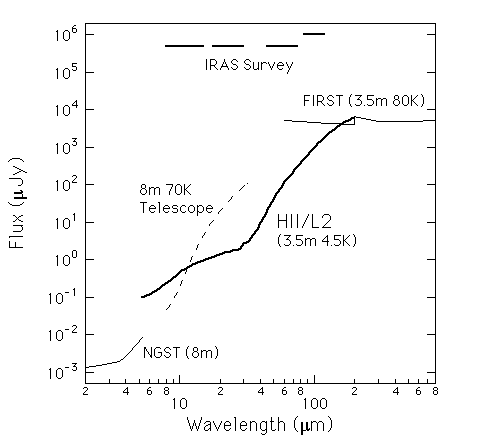A cooled 3.5 m telescope is a huge jump from previous infrared astronomical missions with small telescopes.
Figure 6 shows the photometric sensitivity of the HII/L2 mission for point sources as a function of wavelength. The noise is dominated (1) by detector noise at the shortest wavelength, (2) by photon fluctuation of zodiacal light radiation at mid-infrared, and (3) by ``confusion noise7'' at the longer wavelength.
Since the HII/L2 has a cooled telescope,
it can achieve superior sensitivity
throughout the infrared wave band.
With these sensitivities, we can make many, important
observations.
For example, HII/L2 is an optimum platform to challenge the
direct detection of
Jupiter-like planets in extrasolar planetary systems.
The advantage of HII/L2 is that it has very good sensitivity
at wavelength longer than 10 ![]() m, where the ratio of planet
to stellar flux increases significantly.
The stable condition at S-E L2
allows us to use a coronagraphic camera in the
diffraction-limited regime and to suppress the
stellar flux efficiently.
The high spatial resolution of HII/L2 (0.7'' at 10
m, where the ratio of planet
to stellar flux increases significantly.
The stable condition at S-E L2
allows us to use a coronagraphic camera in the
diffraction-limited regime and to suppress the
stellar flux efficiently.
The high spatial resolution of HII/L2 (0.7'' at 10 ![]() m)
offers the possibility to detect a planet 10 AU away from a
star at the distance of 10 pc.
m)
offers the possibility to detect a planet 10 AU away from a
star at the distance of 10 pc.
High resolution, diffraction-limited
observations with a large aperture telescope
are very important also in the far-infrared,
where the sensitivity is limited by the confusion noise.
At 50 ![]() m, HII/L2 has excellent sensitivity (40
m, HII/L2 has excellent sensitivity (40 ![]() Jy) and
good spatial resolution (7''). We can
make detailed mapping observations of important
objects, such as protostars
and ultra luminous infrared galaxies, which are relatively
weak at other wavelengths.
Jy) and
good spatial resolution (7''). We can
make detailed mapping observations of important
objects, such as protostars
and ultra luminous infrared galaxies, which are relatively
weak at other wavelengths.

Figure 6: Comparison of point-source sensitivity
(5 ![]() flux at 3,600 s integration) of various infrared missions.
Diffraction-limited observations
with
flux at 3,600 s integration) of various infrared missions.
Diffraction-limited observations
with ![]() = 5 is assumed for the HII/L2 mission.
An 8 m mission at 1 AU is assumed for NGST8.
= 5 is assumed for the HII/L2 mission.
An 8 m mission at 1 AU is assumed for NGST8.
Spectroscopic observations are one of the key roles of the HII/L2 mission. The HII/L2 mission covers a unique wavelength range which includes many vibrational-rotational transitions of important molecules (in near- and mid-infrared) as well as many rotational transitions of light molecules (in far-infrared). Hence the HII/L2 mission will play an essential role to understand interstellar chemistry and physics. It will also serve as a unique tool to study circum-stellar material.
The HII/L2 mission can also detect many fine structure lines from ions and atoms. Since these lines cover various stages ionization, they are useful tools to study physical conditions of various phases of interstellar gas. The lines will also give us important information on energy sources of deeply embedded source, such as those in ultra luminous infrared galaxies, which cannot be studied in shorter wavelength due to large extinction.
The HII/L2 mission also covers most PAH features. The features themselves are very important to understand interstellar chemistry and physics. Moreover, they can be used as very powerful tools to determine the redshift of many, faint galaxies. Since the equivalent width of the feature is very large, the features can be measured by low-resolution spectroscopic observations. Hence, using the PAH features, we can achieve good sensitivity and very high efficiency to determine the redshift of galaxies, and can reveal the history of galaxy formation and evolution.